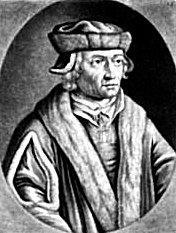Planning worship?
Check out our sister site, ZeteoSearch.org,
for 20+ additional resources related to your search.
- |
User Links
Search Results
When Jesus hung upon the cross
Author: Johann Boeschenstein Appears in 3 hymnals
When Jesus hung upon the cross
When Jesus hung upon the cross
Hymnal: A Collection of Hymns for the Use of the Protestant Church of the United Brethren. (New and Rev. ed.) #96 (1819) Languages: English
When Jesus hung upon the cross
When Jesus hung upon the cross
Hymnal: A Collection of Hymns, for the Use of the Protestant Church of the United Brethren. New and Revised ed. #110 (1832) Languages: English
When Jesus hung upon the cross
When Jesus hung upon the cross
Author: Johann Boeschenstein Hymnal: A Collection of Hymns for the Use of the Protestant Church of the United Brethren. Rev. ed. #d874 (1813) Languages: English
When Jesus hung upon the cross
Johannes Böschenstain

1472 - 1540 Author of "When Jesus hung upon the cross, Expiring to retrieve our loss" Böschenstein, Johann, son of Heinrich Böschenstein, a native of Stein on the Rhine, was born at Esslingen, Wurttemberg, in 1472. After taking Holy Orders as a priest he became, in 1505, tutor of Hebrew at Ingolstadt. Leaving this in 1514 he went to Augsburg, where, in the same year, he published a Hebrew Grammar, and in 1518, by the recommendation of Reuchlin, was invited as tutor of Greek and Hebrew to Wittenberg, where he had Melanchthon as a pupil. In 1519 he went to Nürnberg; 1521 to Heidelberg; and in 1522 to Antwerp. After a short stay in Zurich, where he taught Hebrew to Zwingli, he settled, in 1523, at Augsburg, where he became by royal license teacher of Hebrew, and where he d. 1539. (Koch, i. 219-221, ii. 469-471; Allgemeine Deutsche Biographie, iii. 184-186, the latter stating that he resided at Nürnberg in 1525, and then went to Nördlingen; and died there in great poverty 1540.) Koch quotes 4 of his hymns, the best being:—
Da Jesus an dem Kreuze stund. [Passiontide.] Wackernagel, ii. p. 1091, gives two forms, the first in 9 stanzas of 5 lines "Do lhesus an dem creutze stüund", from an undated leaflet, c. 1515, the 2nd from M. Vehe's Gesang-Buch 1537. It has been, but Wackernagel thinks erroneously, called a translation from the Latin of Peter Bolandus ("Stabat ad lignum crucis"). Kehrein, in his Kitchen-und religiöse Lieder, Paderbom, 1853, p. 198, quotes it from a paper manuscript which he dates xvth century. The first form is No. 73 in Porst's Gesang-Buch, edition 1855. The later version of the Seven Words on the Cross, “Da Jesus an des Kreuzes Stamm" (q. v.), has superseded it in most modern hymn-books. Translated as "When Jesus on the Cross was found," No. 385 in pt. ii. of the Moravian Hymn Book, 1746. In 1789 it was rewritten as, "When Jesus hung upon the Cross."
[Rev. James Mearns, M.A.]
-- John Julian, Dictionary of Hymnology (1907)
Johannes Böschenstain


 My Starred Hymns
My Starred Hymns


